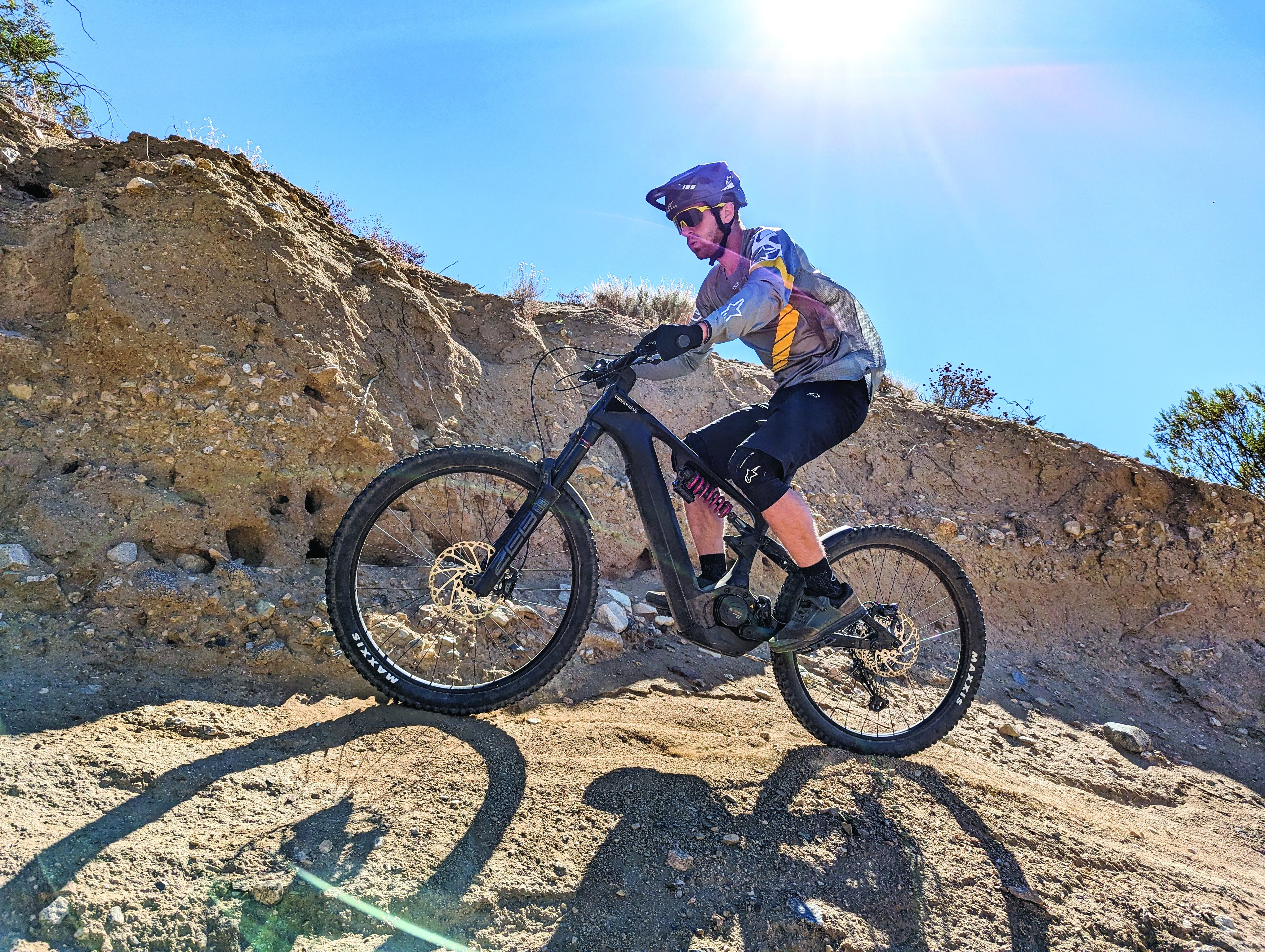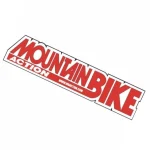LONG TERM REVIEW: CANNONDALE MOTERRA NEO LT – THE LONG-TRAVEL ELECTRIC JOYRIDE
A big mountain ebike with all the range, all the power and all the suspension travel

LONG TERM REVIEW: CANNONDALE MOTERRA NEO LT
Cannondale’s first attempt at an electric-assist mountain bike came in the form of a questionable-looking Moterra in 2016. But, to be fair, so were all eMTBs back then. Later in 2020, the Moterra came back as a sleek, modern-styled mountain bike, and then it split the line into three models: the lightweight trail-focused Moterra SL, all around Moterra Neo and enduro-driven Moterra Neo LT. We tested the LT version with 165mm of coil-sprung rear suspension and a big-hit attitude.
DRIVE SYSTEM
Bosch’s Performance Line CX Smart System powers the Moterra, producing a maximum of 85 N/m of torque from its electric motor. It comes with Bluetooth connectivity via Bosch’s eBike Flow app where riders can tune its modes for assist percentage, power delivery and cutoff speed. The Tour and the more powerful eMTB mode automatically adjust power output based on torque and cadence.
Everything is controlled through the LED remote switch, and Cannondale includes the Kiox 300 color display so you can see all the ride stats at a glance. Paired to the motor is a Bosch PowerTube 750Wh battery pack that’s hidden under a removable cover on the downtube and is changed by a 4-amp charger. The bike also comes pre-wired for an accessory headlight that can be added on and taillight wiring that needs to be installed.
FRAME
Cannondale constructs the Moterra Neo’s front triangle out of size-specific-tuned carbon fiber and the rear out of its SmartForm C1 alloy. Geometry is consistent across the size range, with 64-degree head angles, 76.5-degree effective seat tube angles, and somewhat lengthy 452mm long chainstays on all sizes. Reach on our size-large test bike comes in at 476mm, which is par for the course on many enduro bikes these days. This geometry is fixed and without any sort of adjustments.
Cable routing is internal and enters the front of the frame through the headset. There is a single water-bottle cage mount on the downtube and, of all things, a small kickstand mount on the non-drive-side rear dropout. It is offered in Cool Mint and the Matte Black color we tested.
SUSPENSION
The Moterra Neo LT gets its 165mm of rear-wheel travel through a tried-and-true, Horst-link-style, four-bar rear suspension system. Cannondale designs each frame with its Proportional Response size-specific layout that’s claimed to be optimized for the average weight and size of the rider. The rear suspension is damped with a RockShox Deluxe Select+ coil shock with an externally adjustable rebound and dual-mode compression climb switch. The rear suspension is matched to an air-sprung 170mm travel RockShox Lyrik Select+ fork. It has adjustable rebound and low-speed compression.

COMPONENTS
Cannondale’s Moterra Neo LT is offered in two versions: a Shimano XT-equipped Carbon 1 selling for $8,650 and the Carbon 2 that we tested here. It comes with the always-impressive SLX drivetrain and costs $7,000.
This model is supposed to come spec’d with SRAM Code R brakes, but our bike came with Shimano SLX brakes instead. With recent supply-chain disruptions, it has not been uncommon to see slightly different specs. In this case, it is a welcome change. Although we have generally had mized results with Code R brakes depeding on rotor spec, the Shimano SLX system with its finned pads, a 220mm front rotor and a 203mm rear performed admirably even on this heavy gravity-inspired bike.

The stellar combo of the Maxxis Assegai and Minion DHR II tires left us with no complaints, and WTB’s ST I30 aluminum rims got the job done in a workman-like fashion. Based on looks alone, we thought the Fabric Scoop saddle might be uncomfortable, but it’s surprisingly supportive. Cannondale-branded bar, stem and dropper post also worked fine throughout testing.
CLIMBING
Going uphill in a wide variety of situations is a pleasure on the Moterra. Its cockpit is roomy and places the rider in an efficient pedaling position. One of the first things that stood out to us as we got on the bike was how you feel like you’re up on top of it instead of down inside. It’s a tall-feeling bike. It’s a half to three-quarters of an inch higher than many others, and you can feel it.
The added height offers extra pedal clearance that’s noticeable in rocky technical climbs, making them easier to power up than on lower bikes. There were a few situations on ultra-steep climbs where the higher center of gravity became a negative, but in most climbing scenarios it is a plus.

Even though it’s a long-travel bike that’s not on the lightweight side, it scoots uphill with authority. Part of this is due to Bosch’s powerful system. It has strong power, even on a heavier long-travel bike like this. It pulls harder than all but Rocky Mountain’s Powerplay and Bosch’s own Race version of this motor over the top of steep, power-sucking rollers.
Another part of its climbing prowess comes from a very quiet pedaling suspension system. Even with the active coil shock out back, there is minimal movement while pumping away at the pedals.
Something else test riders noticed about this bike, particularly while climbing, is how loud it is. Everything from shifting to motor noise seems amplified by the frame. It’s not over-the-top annoying, but it is noticeable, especially when riding it back to back with other bikes. Overall, the bike is quiet and without rattles, but you sure hear it when a rock bounces off the battery cover.
Something else that stood out to us is the bike’s above-average heat management. Even under full boost on long, steep, sustained climbs that have affected other bikes, it never overheated or reduced power.

DESCENDING
With a plush coil shock, generous travel and slack geometry, the Moterra has a big appetite for descents. Our 160-something-pound test riders had to swap the 600-pound spring for a 550-pound version to really dial things in, but after that, setup is fast and easy. Even setting sag on the coil shock is a breeze, thanks to RockShox’s printed sag percentages on the shock shaft.
Its suspension performed quite well overall. Even with the limited damping adjustments, riders were able to set the bike up for hard riding with a plush yet controlled feel. The fork has a tendency to dive in the wide-open mode and benefits from a click or two of compression to help hold it up.

From steep and technical to fast and flowy, it performed well on them all. Test riders felt confident charging through the chunder and rarely got kicked offline. It has a long, stable feel to it that lends itself more to high-speed predictability than corner flickability. Even with the long feel, cornering is easy on all but the tightest switchbacks, but even then, we’ve tested far worse.
That tall sensation that we felt on the climbs is less noticeable on the descents, but the bike still has a higher-than-average feel to it. One trait that really stood out on the Moterra LT is its planted feel. Between the weight and sensitivity of the coil shock, it seemed to find grip where others skipped, and it hugged tricky off-cambers with tenacity.

WHAT DID WE LOVE?
In addition to the well-rounded nature of this long-travel mountain bike, we appreciated a few small details, such as its front and rear bolt-on fenders and a nicely placed water bottle cage mount with plenty of room for large bottles.
Another nifty detail is its rather well-sealed charge port. A clasp locks the port’s door and holds its foam backing snugly against the port, keeping it clean and dry.
WHAT DID WE HATE?
We have been complaining about size and function of Bosch’s LED remote switch for a while now, but after using their new excellent wireless Bluetooth remote on other bikes, we dislike the LED version even more. It’s big, difficult to use and belongs on a commuter bike. We feel even stronger about the large display hanging off the handlebars. It’s gangly and clutters up the handlebars. Since we’re able to get critical information from the LED remote and all other info from the Flo app, we simply removed the display and cleaned up the cockpit.
Cannondale’s headset cable routing and integrated stem preload cap complicated height adjustments. The bike comes with tubes, and its rims are taped for tubeless, but valve stems are not included, so you’ll have to buy your favorites.

BOTTOM LINE
Even though the Moterra Neo LT is a long-travel, enduro-focused bike, it comes with versatility that makes it a great all-arounder.
While it performs well in every aspect of enduro-style riding and long adventure-style outings, this jack of all trades has a bit of a vanilla feel to it. We’ve tested bikes in this category with more pop and liveliness, and even ones that rail ultra-steep stuff harder, but few are as well rounded as the Cannondale. It’s both its greatest attribute and weakness.
If you’re looking for an eMTB with strong character, there are others that stand out in particular ways. However, if you want an all-around electric mountain bike with lots of suspension travel, the Cannondale is a great option.

CANNONDALE MOTERRA NEO LT CARBON 2
CATEGORY: eMTB Enduro
WHEEL SIZE: 29″ (front), 27.5″ (rear)
SUSPENSION: 170mm (front), 165mm (rear)
Price: $7,000
Weight: 57 pounds (without pedals)
Sizes: S, M, L (tested), XL
Frame tested: Carbon front triangle, aluminum rear, 165mm travel
Motor: Bosch Performance Line CX Smart System
Battery: Bosch Powertube 750Wh
Controller: Bosch LED
Display: Bosch Kiox 300
Shock: RockShox Deluxe Select+
Fork: RockShox Zeb Select, Charger RC, 170mm
Wheelset: Formula front/Shimano rear hubs, WTB ST i30 TCS rims
Tires: Maxxis Assegai, 29×2.6”, 3C, EXO+, tubeless-ready front, DHR II, 27.5×2.6”, 3C, EXO+, tubeless-ready rear
Seatpost: Cannondale DownLow dropper (170mm travel)
Saddle: Fabric Scoop Shallow Sport, steel rails
Handlebar: Cannondale 3 riser, 6061 alloy, 25mm rise, 8° sweep, 800mm wide
Stem: Cannondale 2, 6061 alloy, 35mm long
Grips: Fabric FunGuy
Headset: Acros integrated sealed bearing
Brakes: Magura MT5 4-piston
Rotors: Magura MDR-P 220mm (f), 203mm (r)
Rear derailleur: Shimano SLX
Shifters: Shimano SLX
Crankset: FSA Bosch ebike, 160mm
Cassette: Shimano SLX 12-speed, 10-51T
Chain: Shimano SLX
Chainrings: 34-tooth
GEOMETRY SIZE LARGE
Head tube angle: 64°
Effective seat tube angle: 76.5°
Reach: 476mm (18.7”)
Stack: 642mm (25.3”)
Bottom bracket height: 356mm (14”)
Chainstay length: 45.2mm (17.8”)
Wheelbase: 1276mm (50.2”)



![#throwbackthursday with Paola Pezzo, a dominate force in Women’s cross-country racing in the 90s and 2000s under Gary Fisher 🔙
“Paola Pezzo rode for me for 12 years. Some people underestimated her because she had an incredible sense of style, but she was a very disciplined rider who trained really hard to get to where she was able to win two Olympic gold medals [1996 and 2000].” - Gary Fisher
#throwbackthursday #paolapezzo #garyfisher #mtb #mountainbike](https://mbaction.com/wp-content/plugins/instagram-feed/img/placeholder.png)

